Latest news and features

A real Italian espresso – Alfa Romeo Junior Zagato 1600
Photos don’t do it justice; they tend to flatten the curves. Rather than being made of the flat pieces of metal the pictures suggest, this car is in fact a collection of subtle and shaped curved lines that somehow look almost straight — sort of like Twiggy was in exactly the same era. The final result is just as pretty and doesn’t weigh much more than she did.
Milan, in the top left-hand corner of Italy, is a long-established home for Italian fashion houses, a place where craftspeople drape the finest materials over the finest forms to create some of the world’s finest fashion clothing. It is also home to another Italian design and create industry; it is the region that headquarters the Stellantis group, which used to be called Fiat, and Alfa Romeo is a part of that.

The Bronze Blowtorch — Chrysler’s ill-fated turbine car programme
Chrysler’s Ghia-bodied Turbine Car, in its distinctive Turbine Bronze paint and black vinyl top, was a head-turner even before it fired up. To many, its exterior design language echoed that of Ford’s Thunderbird. This should come as no surprise given that both were guided by Elwood P Engel, who had moved from Dearborn to Highland Park in 1961 after having designed the 1961–1963 third-generation T-bird. It’s engine, however, was something else altogether.
On 15 May 1962, Chrysler announced the limited production build of 55 gas turbine-powered cars. The cars would be lent to 203 drivers for three-month test drives over a period spanning more than two years. Only 46 cars actually went to the general public. Five were prototypes, two were held by Chrysler for marketing and dealer programmes while two were stars of the Chrysler pavilion at the 1964–65 New York World’s Fair.

Porsche New Zealand Celebrates Certification of New Porsche Classic Technicians
Porsche New Zealand proudly announces that three of their talented technicians have successfully completed the prestigious Porsche Classic Technician training program and are now officially Certified Porsche Classic Technicians.
Ricky Urry and Kai Newstead of Giltrap Porsche, along with Savannah Mountney-Needham from Continental Cars Porsche, have demonstrated exceptional skill and dedication throughout the rigorous training process. This accomplishment is a testament to their unwavering commitment to preserving and servicing classic Porsche vehicles to the highest standards.

Almost mythical pony
The Shelby came to our shores in 2003. It went from the original New Zealand owner to an owner in Auckland. Malcolm just happened to be in the right place with the right amount of money in 2018 and a deal was done. Since then, plenty of people have tried to buy it off him. The odometer reads 92,300 miles. From the condition of the car that seems to be correct and only the first time around.
Malcolm’s car is an automatic. It has the 1966 dashboard, the back seat, the rear quarter windows and the scoops funnelling air to the rear brakes.
He even has the original bill of sale from October 1965 in California.

Becoming fond of Fords part two – happy times with Escorts
In part one of this Ford-flavoured trip down memory lane I recalled a sad and instructive episode when I learned my shortcomings as a car tuner, something that tainted my appreciation of Mk2 Ford Escort vans in particular. Prior to that I had a couple of other Ford entanglements of slightly more redeeming merit. There were two Mk1 Escorts I had got my hands on: a 1972 1300 XL belonging to my father and a later, end-of-line, English-assembled 1974 1100, which my partner and I bought from Panmure Motors Ford in Auckland in 1980. Both those cars were the high water mark of my relationship with the Ford Motor Co. I liked the Mk1 Escorts. They were nice, nippy, small cars, particularly the 1300, which handled really well, and had a very precise gearbox for the time.
Images of Jim Richards in the Carney Racing Williment-built Twin Cam Escort and Paul Fahey in the Alan Mann–built Escort FVA often loomed in my imagination when I was driving these Mk1 Escorts — not that I was under any illusion of comparable driving skills, but they had to be having just as much fun as I was steering the basic versions of these projectiles.
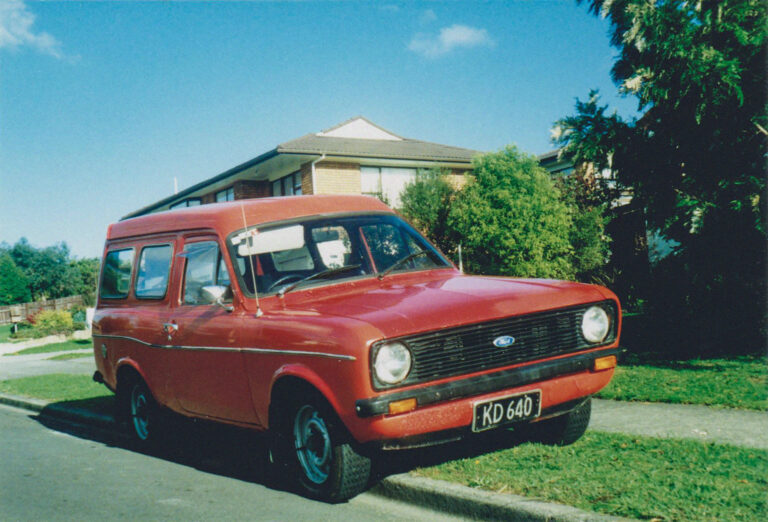
Fear and loathing the blue oval – part one
The slogan went something like ‘There’s a Ford in your future’. ‘Bugger off!’ were always the words that sprung to my mind. Ford and I have never really got on in the manner of many of my friends, so I’d say my relationship to the brand was distant. The accelerating blur of passing time has helpfully blanketed memories of a few Ford encounters which I probably wanted to forget but I have to admit, now I look at them, they are re-appearing through the mists of time. What comes to mind more readily, to quote some uncharitable wit, is that the letters Ford could stand for ‘fix or repair daily’. Still, I have to ’fess up, there were several Fords in my past.
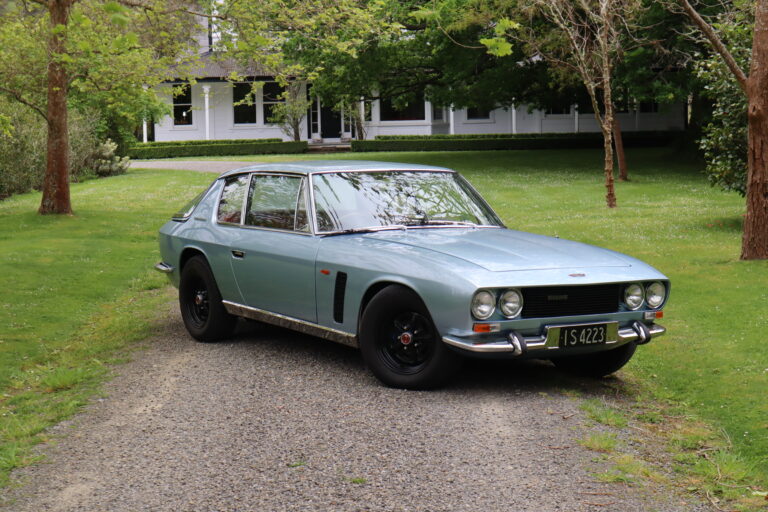
Class struggle
For a British car, it is huge; for those sitting inside, the bonnet seems to extend past the horizon. The front seats are very comfortable rather than body hugging. The dashboard and centre console cluster are beautifully laid out, reminiscent of a fighter plane cockpit, with acres of red leather all around. Its V8 burble is on show. It is not a car to sneak about in, and it gets attention wherever it goes.
The large back window, possibly the best-known feature of the Interceptor and one that sets it apart, has very good functionality, allowing greater access to the boot. It would not be an easy job to replace it, so Interceptor owners are careful about reversing and not hitting anything.

NZ Classic Car magazine, July/August 2024 issue 394, on sale now
Big brash and beautiful
Faced with the possibility of scrapping his cherished 1973 Ford Falcon XA GT 351 Hardtop, David Chase took the plunge, delivering it into skilled hands at Matamata Panelworks. It’s now a stunning classic and 2023 Ellerslie Intermarque Concours Masters Class winner.
This big Aussie brute of a car is our stunning cover car for this issue and the restoration journey of this classic is a fascinating tale with a jaw dropping result.
“Rarely do these Ford Falcon 351 GT hardtops last long in their original state as they are either modified, raced, or rust results in them being scrapped. They are already a rare sight on New Zealand roads and survivors turning up at car shows are well-restored as their values skyrocket past the A$200,000 mark. This is especially the case with David’s car, for a particular reason.
“Surprisingly, it’s an all matching numbers car. Yep, that’s pretty cool. A lot of them lost their motors early on, but mine’s still matching so that’s pretty good and I’m very happy about that.”
With a restoration bill approaching the $200K mark, David is thrilled to see a recent valuation well in excess of the figure.”
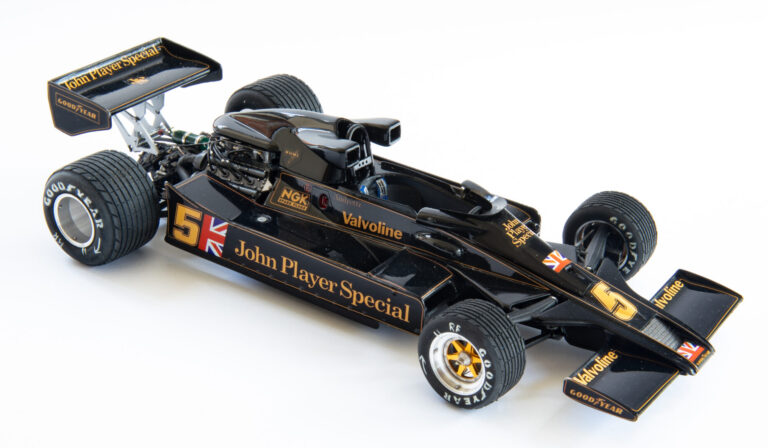
The super-detailed point of difference
Tony Lyne has been building models for as long as he can remember, and he has realised his love for classic Formula 1 in spectacular fashion. As a teenager, Tony was drawn to the ‘elbows out’ style of racing required to keep cars of that era on Formula 1 circuits the world over and the technological race to improve them.
It is hard to fully understand the time, patience, and nerve-racking moments that go into a super-detailed work of art. However, hearing people utter “Where do you put the keys in to start it?”, and watching their eyes bulge as they carefully inspect the finished product, shows that all the hours spent in the spare room looking through the magnifying glass were well spent. These kitsets may have started out as a mere humble model, but they have ended up as true scale works of automotive art.

Saltwater Creek Garage
After passing by this building for many years, I decided to call in and ask the owner about his garage and the car that had been parked there. It was a 1982 Hyundai Pony 1200 TLS that he’d inherited from his mother who had bought it when it was nearly new. I was fortunate enough to buy it from him — many had approached him over the years but were turned away. After sitting out there for that long you could not imagine how dirty it was. At least it had never been wet in all that time. The interior is a mid-blue and almost like new — in fact his mother, Irene, had still retained the original factory-fitted thick clear-plastic cover over the mid-blue vinyl door panels.

Lunch with … Roger Bailey
Roger’s story is a classic illustration of what hard work, honesty to the point of brutal frankness, a ‘can-do’ approach, and a racer’s brain can get you in this sport of car racing. Roger, or ‘Boost’ as he’s known up and down the pitlanes of America, was who Kenny Smith turned to when he was dragging a reluctant teenager around the different pit garages at Laguna Seca.
“Scott [Dixon] kept complaining that it was too hot and he just wanted to go back to the hotel pool. I had to tell him that I was trying to secure his future — we weren’t getting much of a look in until we saw Roger who knew everyone and set about introducing Scott as New Zealand’s next big thing.

The Jowett Jupiter turns 70
John Ball has always enjoyed tinkering with old boats and cars. He’s old enough to think having gearbox parts on newspaper on the floor of his bedroom, while the relevant car sat waiting on nail boxes, was a normal part of growing up. His passion has always tended towards old British bangers. He reckons he’s fortunate not to have got caught up in the American muscle scene.
John’s love affair with this Jupiter started in December 2015 when, with some time on his hands during a Christchurch trip, he searched online for ‘cars, before 1970 and in Christchurch’.

A passion for classics and customs
In the highly competitive field of New Zealand classic and custom restorations, reputations are won or lost on the ability to maintain consistently high standards of workmanship. A company managing to achieve this is D A Panel beating Ltd, of Rangiora near Christchurch. Is your classic or custom car restoration stalled, or in need of a refresh, or perhaps you are looking for experts to rebuild that recent import project out of Europe or the ‘States?

Aspen Siris — A roadster for the wrong time
When I visited George Spratt’s workshop in Auckland, I was impressed with the number of vehicles he had tucked away, mostly hybrid or fully electric. Many of them had started life being petrol powered but George has been tinkering with converting conventionally powered cars to electrical propulsion since the mid ’70s.
The Horizon was George’s first attempt at building a car; it was an evolution of ideas about what was considered to be ideal for a car at that time. The shape and style were governed by the choice of running gear and power plant. The size of the garage restricted walk-around viewing, and it was not until it was almost finished that George was able to push the car out of the garage to get the full picture.

Leonardo’s lighting legacy
Ferrari owner and enthusiast Roger Adshead got to wondering where the simply beautiful twin tail lamps that are a signature of many Ferraris came from and what inspired them. It led him on a fruitful journey…
There are no more defining or memorable Ferrari design cues than a pair of twin circular tail lights, which find their echo in the rear valance in two pairs of circular exhaust tips.
Introduced fifty years ago by Pininfarina designer Leonardo Fioravanti, this charismatic Ferrari identifier has more than stood the test of time.
They first appeared on the Dino 206, and then on the 365 GTB/4 Daytona, two of Signor Fioravanti’s most revered designs.
Unlike Pininfarina’s trademark slim vertical tail lights of the 1960s, which subsequently found their way onto the mass-produced Austins, Morrisses, and Peugeots of the period, the twin circular tail lamps remain emblematic of Ferrari supercars and sportscars.
Some earlier Corvettes copied them, and they have been partially mimicked by Golf Mark V and Honda Civics of similar vintage, and it’s probably no coincidence they added some visual flair to Nissan’s high-performing Skylines, but they have been a recurring theme on Ferraris right through to its latest designs.
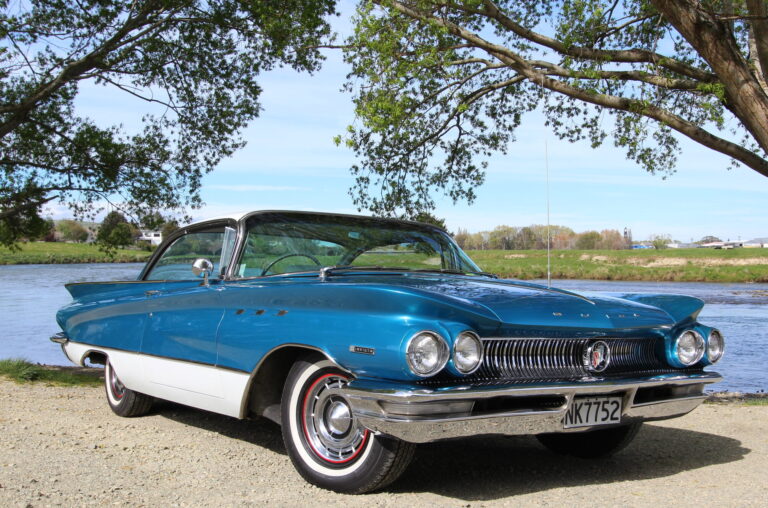
The empire strikes back – 1960 Buick Invicta
In just a few months of ownership, Graham Baird has worked away at his 1960 Buick Invicta two-door to bring it up to the stunning condition we see today. He says it was already in very good condition when he bought it from its previous owner in Invercargill. Unusually, the Buick comes with a very well executed conversion to right-hand drive, which Graham thinks might have been done in New Zealand. It won its first award in October, as the ‘Best Original’ at the recent Hardpark Takeover 2021 car show in Invercargill, as a delighted Graham explains.
“It was Graham Wilkinson’s own personal car but he hardly used it. Graham had it for 17 years and he found it in Te Anau parked up in storage sheds run by an elderly couple who had owned the Buick for about 10 years.”

NZ Classic Car magazine, May/June 2024 issue 393, on sale now
Minis have a passionate following and are adored by millions and millions of classic car lovers worldwide.
Whether it was their first car, a Mini for Mum, road trips with a car filled to bursting with people and luggage, or boy-racing escapades, everyone has a Mini story.
The Mini has the ability to become a member of the family with their cute-as looks and this “yellow one” nicknamed ‘Gertie’ is no different. The Kelly family of Dunedin are dedicated Mini fans from way back and this LE is just one in their collection – albeit something of a favourite.
“The Kellys have more Mini stories than most and this one dates back to June 1978, when Margareta Arthur went to the Dunedin branch of NZMC, City Motors. She bought a brand new Mini 1000LE, trading in a 1976 Mini 1000. She adored her new car, naming it ‘Gertie the Yellow One’. She owned Gertie for the next 18 years before selling it in 1996, when Margareta moved into a rest home. Cathy Cotton was the next owner and Gertie was her first car. She was given a letter from Margareta at the time of sale, asking her to take care of Gertie. Cathy adored Gertie and used it to go to university, including many trips to Central Otago for fruit picking, nearly doubling the odometer in the first year of ownership.”

Penny’s Pagoda – Mercedes Benz 230 SL
We scouted out a few different locations for photographing this car, but they all had one thing in common. At every stop, people could not help but come up and compliment owner Penny Webster on her stunning Horizon Blue Mercedes 230 SL.
There’s something about the ‘Pagoda’ Mercedes — so-called because the distinctive dipping curve of its roofline echoes that of the famous Eastern tiered temples — that encourages people to speak up.
Many classic cars attract a second look, but in most cases people keep their thoughts to themselves. It was striking how many people felt the need to express the warmth of their feelings about this car.
The expansive glass cockpit, the friendly, subtle lines, and its simple three-box shape seem to encourage openness among passers-by.

Motorsport Flashback – Kiwi rallying in the 1970s
Rallying arrived in New Zealand in 1973 like a tsunami. It had been only a few years since the sport was introduced here and shortly afterwards Heatway came on board as the sponsor to take rallying to a new level. The 1973 Heatway would be the longest and biggest yet, running in both islands with 120 drivers over eight days and covering some 5400 kilometres. The winner was 31-year-old Hannu Mikkola — a genuine Flying Finn who had been rallying since 1963 before putting any thoughts of a career on hold until he completed an economics degree. The likeable Finn became an instant hero to many attracted to this new motor sport thing. I was one of them.
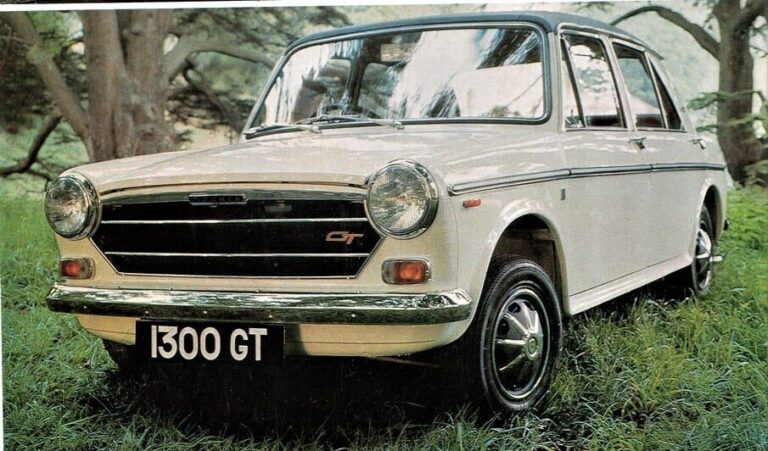
Think of it as a four-door Cooper
New Zealand Mini Owners Club coordinator Josh Kelly of Dunedin loves his Minis. It’s a family affair. Julie and Mike, Josh’s mum and dad, are just as keen, and they can usually all be found taking part in the club’s annual ‘Goodbye, Pork Pie’ charity run from the North of the country to the South.
But lately Josh’s young head has been turned by some other revolutionary BMC cars. He has picked up a couple of Austin and Morris 1100 and 1300s, which he started to restore — that was until an opportunity arose to buy a rare example stored in a shed.

The name’s Aston, Aston Martin
Martyn Jagusch didn’t intend to carry out a ground-up restoration on his 1971 Aston Martin DBS V8. Yet one glance at the car’s pristine condition shows he definitely changed his mind — or had it changed for him, which is nearer the truth.
The Aston Martin DBS V8 is a handsome car that only looks better with age. Enthusiasm for Aston’s earlier cars, especially the James Bond-era DB5 and the earlier super-sexy Zagato models, has been skyrocketing for years but appreciation for these larger and less iconic GT cars languished for a time. The V8 is less well recognized as a Bond car even though George Lazenby drove one in On Her Majesty’s Secret Service in 1969 as did Timothy Dalton in The Living Daylights (1987).

Spectacular historic racing at Phillip Island did not disappoint the large crowd
This year 32 car clubs displayed a total of 1,100 cars — a magnificent sight as well as being an added attraction for the thousands of spectators who braved the very hot weather. There is a pavilion on that same stretch of the circuit that houses stalls offering books, models, enamel signs, parts and all manner of motoring bric-a-brac plus more car displays.
Kiwi Codie Banks dominated all the F5000 races in his Lola T332. For the first race he was joined on the front row of the grid by his father David in his Talon MR1.

Rare rotaries gather in the south
The owners want to remain anonymous at this stage, but they are keen to set up a permanent Mazda display in Dunedin as a drawcard for visitors to that city. “We are keen to involve the Dunedin City Council, who could perhaps set us up in a suitable display. It could be big for Dunedin, judging by the popularity of other Mazda displays overseas,” he said.
A Transport World transporter picked up five Mazdas from Cory Wilson’s workshop for the exhibition, meaning the SP’s owner has barely glimpsed it. “It’s been in New Zealand for some eight months, and I’ve barely seen it, as it has been most of that time at Cory’s. I’ve basically just driven it to his workshop and that’s it.”
The five cars shipped to Invercargill included an RX-4, Mazda’s first full-production rotary-powered car the R100, and a Roadpacer — a Holden HZ body fitted with a rotary engine.

Southern comfort
Derek and Rachel Ayson enjoy cruising southern highways to the easy loping beat of their 1970 Holden HT GTS350 Holden Monaro. Powered by Chevrolet’s popular 350 cu. in. V8, the motor has found favour in many restomod classic cars and developed a great reputation for reliability and satisfying performance.
The car it powers was originally a factory-built GTS in white with a blue interior, fitted with Holden’s 186 cu. in. six. Derek bought it in 2007 from good friends Russell and Catherine Harrex of Dunedin. During the mid 1990s the Harrexes had had the car stripped to bare metal.

Lunch with… Brian Lawrence
Hearing Brian’s stories at the Levin tribute day (see Motorsport Flashback) made me realise that despite knowing him for nearly 30 years, there was much about his involvement in motor sport that I didn’t know. Since the ‘Lunch with’ series started, we’ve made a point of focusing on other contributors to the sport beyond the drivers. I’ve ‘lunched with’ journalists, a photographer, mechanics, preparation wizards, and F1 team members, but never before a promoter. In the near future we have lunches planned with more drivers, a team owner, and a sponsor, but now is the time to interview Brian David Lawrence.

NZ Classic Car, March/April 2024 issue 392, on sale now
With this issue 392, we celebrate 60 years of the Ford Mustang.
We commence with a rare Paul Fahey replica Shelby Mustang owned by another kiwi who we should celebrate, Rodger Cunninghame.
Roger has been strutting his stuff with race cars for 50 years now and it seemed appropriate to celebrate both the milestones in this edition even though Roger is retiring from racing now, the Ford Mustang lives on.
Roger is also a longtime member of The Southland Sports Car Club (SSCC) which is also celebrating a big anniversary, its 75th. It sure is celebration time!
Quinton Taylor writes “In 1956, Rodger joined his father Bruce and his mate, club president Des Kilkelly, helping with building new grandstands at Teretonga and the start of a long association with the club.
“I was just a wee kid working with Dad on that. They had been shifted here from some other local sports club and bought here, and they had to put all the seating back on them.”
Rodger always had a liking for making things go faster and it didn’t take him long to tinker with cars as we looked through a couple of very comprehensive scrapbooks recording many amusing moments on and off the racetrack.”

Romancing the automobile and motor racing in art
The glamour and excitement of the automobile first had an impact on me through car advertisements. Growing up on Auckland’s North Shore in the conservative early ’60s, there wasn’t much dynamic stuff going on. Everything was pretty bland and socially constrained, but there were glimpses of a world beyond that lay just out of our grasp. One of these early influences was a pile of late ’50s National Geographic magazines. We received these on subscription from a generous uncle in North America. It wasn’t the articles we were poring over though, it was the advertising, particularly the art-styled American car adverts.
The evocative, lusciously coloured and boldly styled auto adverts hit me like a juggernaut.

TVR Tasmin — proper wedge
Neville Wilson of Napier has been a keen member of the Vintage Car Club for most of his life. He showed me the collection of cars in his garage, including a 1937 Dodge Coupe he has owned for 25 years. Behind that was a 1929 OHC Morris Minor that has been in the family for even longer. It was considered a good buy in 1961. Now retired, Neville enjoys going for runs with other
club members, especially on balmy spring days in a car with the roof down. What could be better than doing it in an old roadster, preferably something with a bit more get up and go than the Morris, lovely though it is? Its 20bhp (15kW) 847cc engine makes it considerably faster than a single horse and cart but not much else.
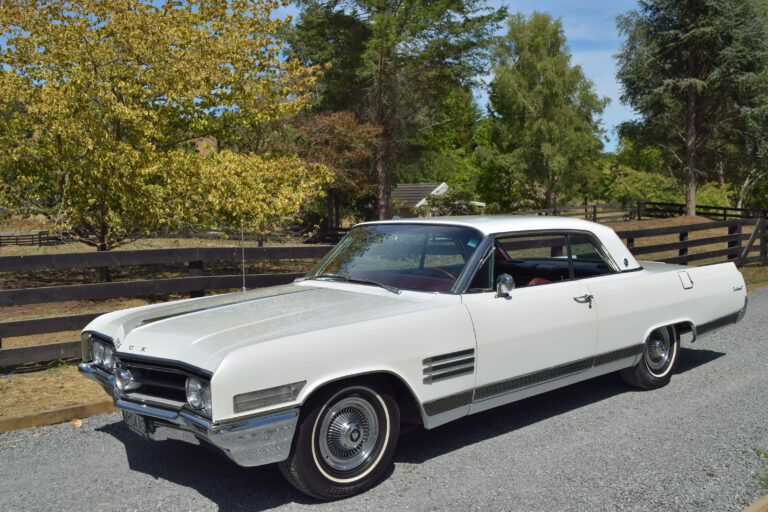
Formula Ford One Cool Cat
In the ’60s Buick was butting heads with the Mustang and Thunderbird, Corvette, Impala, and many others for eight-cylinder supremacy.
In the Buick stable the most well-known of the marque was the Buick Riviera, a competitor in the American version of the luxury auto market and, while it was a two-door, it wasn’t squarely pitted against the popular Ford Thunderbird. Following the introduction of the Riviera in the early ’60s, Buick released another trophy car, the Wildcat.
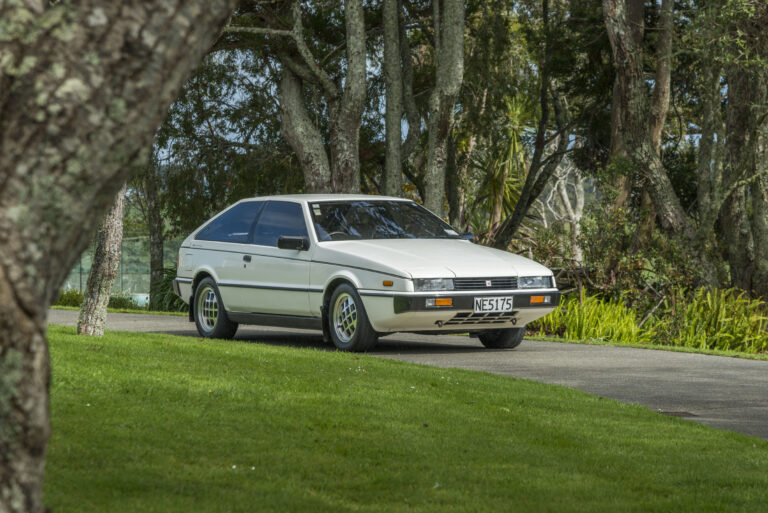
A Giugiaro great
Giugiaro himself — the man who created the Ferrari 250 GT — was pleased with the design that Isuzu had commissioned to be based on a GM Chevette platform. His design, called the Asso di Fiori (Ace of Clubs), was unveiled at the 1979 Tokyo Motor Show to rave reviews. Isuzu fast-tracked it into production.
Carrying the nose forward to refine it just a touch more shows the respect Isuzu had for its lines. It meant engineering in some mechanics to flip up little eyebrows in the bonnet lip to expose more of the lamp glass in this pre high intensity light bulb era. You can imagine most car makers would go, “No, cut it off there”. If Isuzu had, it would certainly have been a less characterful design.
I can remember seeing one or two of them when they were new in the ’80s and feeling a fondness for the car, and for the company that had produced such a clean and restrained design.

TR7 — legend or lemon?
Stuart Bladon, a long-time motoring journalist who spent 25 years at Autocar magazine in Britain, owned one. He rose to deputy editor before he left in 1981. He likes open air driving but was perturbed by high insurance costs for his modest Peugeot 205 CTi convertible. A friend suggested he swap to a classic car with a much cheaper limited use insurance premium and thus he became the owner of a 24,000 mile TR7 convertible, first registered new in August 1982, a year after production ended.
Bladon was the European correspondent for New Zealand Car magazine and Stuart and his charming wife Jenetta kindly invited my family to lunch at their home in Radlett during our time in Britain in 1987. Later that day Stuart simply had to take me out in his prized red TR7, top down, of course.

NZ Classic Car, January/February 2024 issue 391, on sale now
Well, love it or hate it, we have to accept the fact that we made this mustard-coloured, Skoda-chassied, fibreglass vehicle and it’s a true Kiwi classic icon now – we are talking about the Trekka.
They were a hard car to like or in any way admire when they came out in the 1960s and to be honest, as kids, we used to point and laugh at them. However, they are our best attempt at a motorcar industry so it’s time to enjoy all there is to know about this truly unique Kiwi-designed farming vehicle. When you see them in the flesh these days, they really have something about them that we can now, actually appreciate and enjoy as the Trekka… is all ours.
It’s time to own it NZ and our cover story this issue is on two beauties, a ute and a station wagon. Enjoy.
“Thanks to Trekka enthusiast Todd Niall, the intriguing tale of this quirky utility vehicle’s singular rise to stardom as New Zealand’s only genuine ‘mass-produced’ car, has been properly told. It’s a story of the founding dynasties of the New Zealand motor industry, political intrigue, and government manoeuvring, recounted in his book The Trekka Dynasty (Iconic Publishing, Auckland). It’s a great read.
For decades, overseas funds were really the only way you could legally bring a new car into New Zealand. That’s because After World War II, the government was becoming increasingly jittery over the worsening balance of exports payments and import licensing was restrictive and competitive.”
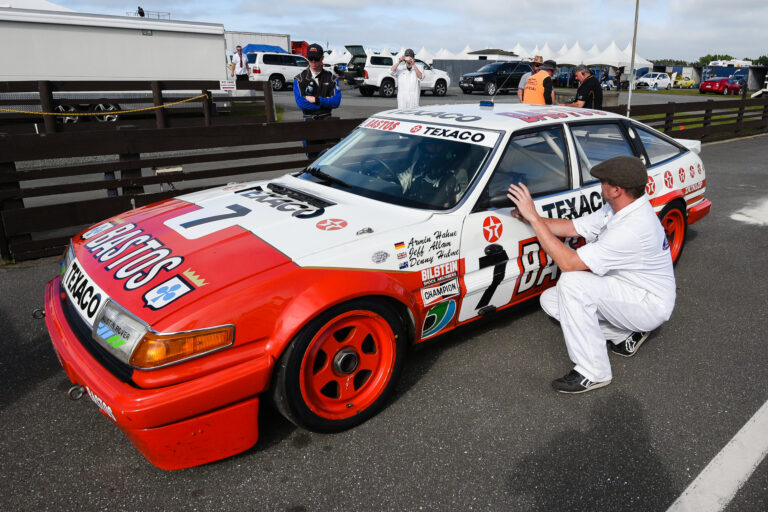
The best of British
There are clues aplenty that this is in fact TWR/018, the genuine V8-engined Rover 3500 SD1 V8 Group A racer built in late 1985 / early 1986 by Tom Walkinshaw Racing in the UK. It was freshened up in Christchurch in the early 1990s by recently retired and relocated TWR engine guru Allan Scott. It is now owned and regularly raced here by keen Wanaka-based classic car owner and driver Allan Dippie.
Dippie is an active member of the largely South Island–based Historic Touring Cars of New Zealand group which, for the past few years, has been running the increasingly popular and well-supported Archibald’s Historic Touring Car Series.
With so many shells built into race (at least 19) and rally cars (as many as another 13), finding a pukka TWR car for sale has never really been a problem — in the UK.

Taipan – surpassing interest
“It’s merely a passing interest,” insists Selby — despite owning three variants of the classic VW Beetle, including an unusual VW van that was sold as a body kit for a Subaru. In his defence he points to a 1961 Ford Thunderbird, a car that he converted to right-hand drive. However, on the VW side of the ledger, since he opened Allison Autos in Whanganui 27 years ago, Selby has built 15 VW-powered Formula First cars, followed by a beach buggy, restored a derelict Karmann Ghia, and hot-rodded a common or garden Beetle into something that has to be seen to be believed. As speed is not something generally associated with classic VWs, though, Selby is still waiting for this particular modification to catch on amongst the hot rod faithful.

Travelling companion
It’s easy to see why the Morris Minor Traveller was one of the best-loved variants of the Morris Minor. Introduced in 1953, it was equipped with the same independent torsion bar front suspension, drum brakes, and rack and pinion steering as its saloon sibling but, with their foldable rear seat increasing versatility, many Travellers were used as trade vehicles, says Derek Goddard. Derek and Gail Goddard, the owners of this superbly restored example, have run Morris Minors since before they were married in 1974.
“Our honeymoon vehicle was a blue Morris Minor van — it was a rust bucket,” says Derek.

Super Leicht Gullwing
It’s fair to say that nothing much in the classic Mercedes world gets past Mercedes-Benz Club stalwart Garry Boyce so it wasn’t surprising to learn that around 15 years ago he had sniffed out an extremely rare 300SL lightweight Gullwing as well as a 1958 300SL Roadster hiding away in the Waikato. The cars were not for sale but Garry eventually managed to persuade the owner to allow him and his restoration team to take a look at the Roadster. They discovered a very distressed but largely unmolested car. The car was so original that the body had never been off the chassis, meaning most of the parts and fittings were still present and correct, as they had been fitted by the factory.

Snake bites twice – 1998 Ford Mustang
The Mustang almost ceased to exist during the late ’80s. Plans were made to replace it with a re-badged front-wheel-drive Mazda MX6. The Fox-body Mustang, barely recognised as a Mustang by the ill-informed, was stumbling towards the end of the longest production run of any Mustang in history, from 1979 to 1993. The third generation Fox-body looked more like a family two-door hatchback than a sports car and sales steadily declined. Ford, who at the time owned a large percentage of Mazda, not wanting to spend money developing a new car for a dying market, believed that a restyled Mazda MX6 might be the cheapest way to give the Mustang brand a shot in the arm.

Pallas Athena — The French Goddess
Love lost and found again!
Like all cars there are the favourites. When it comes to the Citroën DS, there are those, like Classic and Sports Car and certain former French presidents, who love it, and there are those who think it is an acquired taste.
Stuart Bilbrough sits squarely in the ‘love it’ camp. When seeing his first DS in the late ’80s, owned by Max Earnshaw, a manager at the Christchurch-based accounting firm Stuart had recently joined, he set his sights on owning one.
It wouldn’t be until returning from his long OE in 1999 that he would buy his first DS, a 1974 DS23 from Masterton-based Citroën specialist, Terry Falkner.

On the road with a GT40
Riding in a genuine Ford GT40 with Geoff Manning is like living a slice of automotive history, as Donn Anderson found out over three decades ago …
The phone call in 1990 was dead easy to accept. Geoff Manning was ringing to ask if I would like to spend some time with the only genuine Ford GT40 to have driven the roads of New Zealand. There was little time to ponder since the car was destined to return to England and new owner Ted Rollason.
My answer, of course, was positive and immediate — and what a rare and fleeting experience a few days later to be driving around Auckland streets in such a stunning and wonderful machine.
